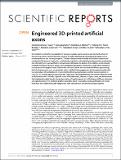| dc.contributor.author | Homan, Kimberly A. | |
| dc.contributor.author | Espinosa Hoyos, Daniela | |
| dc.contributor.author | Jagielska, Anna | |
| dc.contributor.author | Du, Huifeng | |
| dc.contributor.author | Busbee, Travis Alexander | |
| dc.contributor.author | Anderson, Daniel Griffith | |
| dc.contributor.author | Fang, Xuanlai | |
| dc.contributor.author | Lewis, Jennifer A. | |
| dc.contributor.author | Van Vliet, Krystyn J | |
| dc.date.accessioned | 2018-11-05T16:41:07Z | |
| dc.date.available | 2018-11-05T16:41:07Z | |
| dc.date.issued | 2018-01 | |
| dc.date.submitted | 2017-09 | |
| dc.identifier.issn | 2045-2322 | |
| dc.identifier.uri | http://hdl.handle.net/1721.1/118879 | |
| dc.description.abstract | Myelination is critical for transduction of neuronal signals, neuron survival and normal function of the nervous system. Myelin disorders account for many debilitating neurological diseases such as multiple sclerosis and leukodystrophies. The lack of experimental models and tools to observe and manipulate this process in vitro has constrained progress in understanding and promoting myelination, and ultimately developing effective remyelination therapies. To address this problem, we developed synthetic mimics of neuronal axons, representing key geometric, mechanical, and surface chemistry components of biological axons. These artificial axons exhibit low mechanical stiffness approaching that of a human axon, over unsupported spans that facilitate engagement and wrapping by glial cells, to enable study of myelination in environments reflecting mechanical cues that neurons present in vivo. Our 3D printing approach provides the capacity to vary independently the complex features of the artificial axons that can reflect specific states of development, disease, or injury. Here, we demonstrate that oligodendrocytes' production and wrapping of myelin depend on artificial axon stiffness, diameter, and ligand coating. This biofidelic platform provides direct visualization and quantification of myelin formation and myelinating cells' response to both physical cues and pharmacological agents. | en_US |
| dc.description.sponsorship | National Multiple Sclerosis Society (U.S.) (RG4855A1/1) | en_US |
| dc.description.sponsorship | Singapore-MIT Alliance. BioSystems and Micromechanics (BioSyM) Inter-Disciplinary Research Group | en_US |
| dc.description.sponsorship | Saks-Kavanaugh Foundation | en_US |
| dc.description.sponsorship | Roche Postdoctoral Fellowship Program | en_US |
| dc.description.sponsorship | GETTYLAB | en_US |
| dc.publisher | Springer Nature | en_US |
| dc.relation.isversionof | http://dx.doi.org/10.1038/S41598-017-18744-6 | en_US |
| dc.rights | Creative Commons Attribution 4.0 International License | en_US |
| dc.rights.uri | http://creativecommons.org/licenses/by/4.0/ | en_US |
| dc.source | Nature | en_US |
| dc.title | Engineered 3D-printed artificial axons | en_US |
| dc.type | Article | en_US |
| dc.identifier.citation | Espinosa-Hoyos, Daniela, Anna Jagielska, Kimberly A. Homan, Huifeng Du, Travis Busbee, Daniel G. Anderson, Nicholas X. Fang, Jennifer A. Lewis, and Krystyn J. Van Vliet. “Engineered 3D-Printed Artificial Axons.” Scientific Reports 8, no. 1 (January 11, 2018). | en_US |
| dc.contributor.department | Harvard University--MIT Division of Health Sciences and Technology | en_US |
| dc.contributor.department | Massachusetts Institute of Technology. Department of Biological Engineering | en_US |
| dc.contributor.department | Massachusetts Institute of Technology. Department of Chemical Engineering | en_US |
| dc.contributor.department | Massachusetts Institute of Technology. Department of Materials Science and Engineering | en_US |
| dc.contributor.department | Massachusetts Institute of Technology. Department of Mechanical Engineering | en_US |
| dc.contributor.department | Koch Institute for Integrative Cancer Research at MIT | en_US |
| dc.contributor.mitauthor | Espinosa Hoyos, Daniela | |
| dc.contributor.mitauthor | Jagielska, Anna | |
| dc.contributor.mitauthor | Du, Huifeng | |
| dc.contributor.mitauthor | Busbee, Travis Alexander | |
| dc.contributor.mitauthor | Anderson, Daniel Griffith | |
| dc.contributor.mitauthor | Fang, Xuanlai | |
| dc.contributor.mitauthor | Lewis, Jennifer A. | |
| dc.contributor.mitauthor | Van Vliet, Krystyn J | |
| dc.relation.journal | Scientific Reports | en_US |
| dc.eprint.version | Final published version | en_US |
| dc.type.uri | http://purl.org/eprint/type/JournalArticle | en_US |
| eprint.status | http://purl.org/eprint/status/PeerReviewed | en_US |
| dc.date.updated | 2018-10-11T16:24:26Z | |
| dspace.orderedauthors | Espinosa-Hoyos, Daniela; Jagielska, Anna; Homan, Kimberly A.; Du, Huifeng; Busbee, Travis; Anderson, Daniel G.; Fang, Nicholas X.; Lewis, Jennifer A.; Van Vliet, Krystyn J. | en_US |
| dspace.embargo.terms | N | en_US |
| dc.identifier.orcid | https://orcid.org/0000-0001-8741-9178 | |
| dc.identifier.orcid | https://orcid.org/0000-0001-6281-4120 | |
| dc.identifier.orcid | https://orcid.org/0000-0001-5629-4798 | |
| dc.identifier.orcid | https://orcid.org/0000-0001-5713-629X | |
| dc.identifier.orcid | https://orcid.org/0000-0001-5735-0560 | |
| mit.license | PUBLISHER_CC | en_US |
